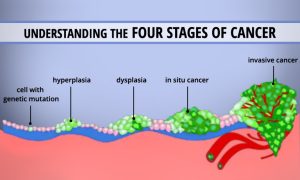Cancer, a formidable adversary to human health, manifests in various forms and stages, presenting unique challenges and complexities along the journey of diagnosis, treatment, and survivorship. Central to this journey is the concept of cancer staging, a systematic process that classifies the extent and spread of the disease. In this article, we embark on a comprehensive exploration of the stages of cancer, unraveling their significance and implications for patients, caregivers, and healthcare providers.

Stage 0: The Precursor Stage
Stage 0, often referred to as carcinoma in situ, represents the earliest phase of cancer development, where abnormal cells are confined to the site of origin without invading surrounding tissues. While not yet invasive, stage 0 serves as a critical warning sign, highlighting the importance of early detection and intervention to prevent progression to more advanced stages.
Stage I: Embracing Hope
In stage I, cancer remains localized to its site of origin, presenting a glimmer of hope for patients as treatment options hold the promise of cure. Surgical resection, radiation therapy, and targeted interventions are among the primary modalities employed to eradicate cancer cells and prevent recurrence. With vigilant surveillance and adherence to treatment plans, many individuals with stage I cancer achieve favorable outcomes and long-term survival.
Stage II: Facing Challenges
Stage II marks a transition to more advanced disease, characterized by larger tumor size or regional spread to nearby tissues or lymph nodes. Despite the increased complexity, patients with stage II cancer still have opportunities for curative treatment, albeit often requiring a multidisciplinary approach combining surgery, chemotherapy, and radiation therapy. Navigating through the challenges of treatment side effects and emotional upheaval, patients and caregivers stand resilient in their pursuit of overcoming cancer.
Stage III: Confronting Adversity
As cancer progresses to stage III, the battle intensifies with the infiltration of nearby lymph nodes or tissues beyond the primary site. Treatment becomes more aggressive, aiming to eradicate cancer cells and prevent further spread. While the road may be fraught with obstacles, advancements in oncology offer newfound hope through innovative therapies and personalized treatment strategies tailored to individual patient profiles.
Stage IV: Embracing Life
In the realm of stage IV cancer, characterized by distant metastasis to organs or tissues throughout the body, the focus shifts from cure to palliation and quality of life. Despite the daunting prognosis, patients find solace in the support of palliative care teams, who strive to alleviate symptoms, manage pain, and optimize comfort. Embracing life in the face of uncertainty, individuals with advanced cancer draw strength from cherished moments and meaningful connections with loved ones.
The journey through the stages of cancer is a testament to the resilience of the human spirit, marked by moments of triumph, adversity, and profound courage. As we traverse the landscape of cancer diagnosis and treatment, each stage offers valuable insights and opportunities for growth, underscoring the importance of compassionate care, unwavering support, and a relentless pursuit of hope. Together, we navigate the complexities of cancer, united in our commitment to improving outcomes and enhancing the lives of all those affected by this formidable disease.


